Archive for the ‘53 Animal Welfare!’ Category
Tuesday, November 4th, 2014
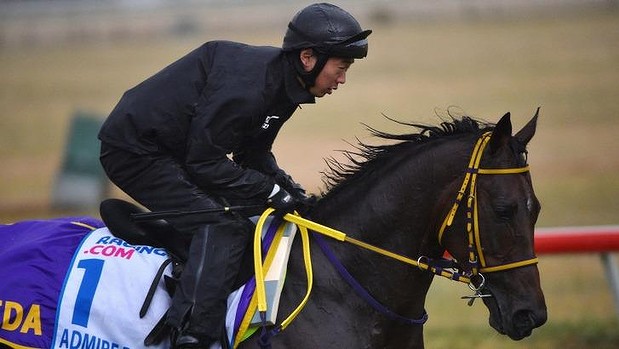 Horse ‘Admire Rakti’: dead from cruel abuse Horse ‘Admire Rakti’: dead from cruel abuse
.
A horse bred for racing and named Admire Rakti was overloaded and overwhipped in the 3,200 metre long Melbourne Cup race today.
The seven-year-old stallion, had just won the Caulfield Cup two weeks before, and so was handicapped by having 58.5 kg in weight, just to even out the betting odds.
On a hot 28 Celsius day, the horse was flogged into the race lead, then his heart gave way, finishing last, collapsing five minutes after the race and then had a heart attack, and so tragically died for sport. The race that stops a nation kills horses.
The RSPCA issued a statement calling for a full and transparent investigation.
The 30 protesters from the Coalition for the Protection of Racehorses had gathered around the main gate at Flemington Racecourse chanting “racing kills”. They were right.
The group’s spokesman Ward Young, said Admire Rakti’s death was another example of horses being overworked on the racetrack. “Racing does kills horses and we think a lot more needs to be done to make horse racing safer. These incidents are a lot more frequent than people know about.”
He said in the past year about 125 horses have died during or shortly after a race.
This time, Mr Young said they were letting racegoers know that a horse had died “because last year the only people who knew about Verema dying in the Melbourne Cup were the people who bet on her”.>>
.
[Source: ‘Melbourne Cup 2014: Last-placed Admire Rakti dies‘, by Patrick Bartley, Adam Pengilly, Ronny Lerner, The Age newspaper, 20141104, ^http://www.theage.com.au/sport/horseracing/melbourne-cup-2014-lastplaced-admire-rakti-dies-20141104-11gpjk.html]
.

.
In Nashville, USA in 2012, a horse bred to be a steeplechase thoroughbred and named Arcadius won the Iroquois Steeplechase over three miles and eighteen hurdles.
He galloped under the pain and fear of the horse whip. His owner won $150,000 from the race.
Immediately after the race, the 8-year-old gelding, breathed hard as he walked back to applause. The humans lined up, the horse was led in to the winner’s circle. Catching his breath now, he stood for the brief ceremony — a sweaty, dirty, hot, victorious athlete.
It was as if he knew he had won. Arcadius stared regally to the distance, ears at attention, and everyone else paused, soaking in the victory. The cameras buzzed. Crowley jumped down, unbuckled the elastic girths, removed the leather saddle, breastplate, black and red cloth with the white 3 on it. The jockey folded it all up on his arm, patted his horse on the back, one more reward for the effort.
Two minutes later, Arcadius was dead — steps from the finish line he had crossed with so much power, so much life.
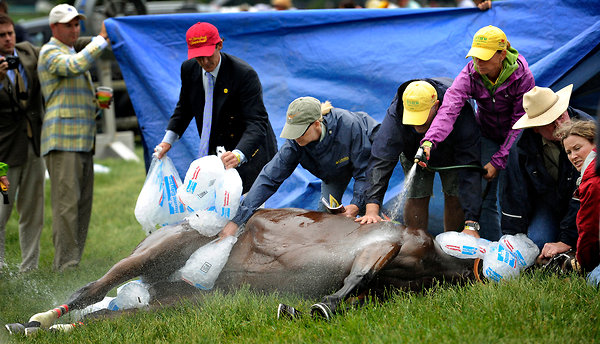 Arcadius: dead from cruel abuse, hidden from punters’ view Arcadius: dead from cruel abuse, hidden from punters’ view
.
It was quick, shocking, certainly eerie. After walking from that winner’s circle celebration, while getting the usual after-race hosing and dousing with water, Arcadius stepped awkwardly to his right, raised his head, stiffened his front legs and dropped to the ground on his left side.
Before he fell, his right eye went blank — flashing life, death, pain, something. >>
.
[Source: ‘After the Best Race of His Life, a Horse’s Death‘, by Joe Clancy, 20120514, ^http://www.nytimes.com/2012/05/15/sports/after-his-lifes-best-race-death-of-horse-arcadius.html?pagewanted=all&_r=0]
.

.
Further Reading:
.
[1] ‘Whips in Racing‘, RSPCA, ^http://www.rspca.org.au/campaigns/whips-racing .
.
[2] The Coalition for the Protection of Racehorses, website, ^http://www.horseracingkills.com/ .
.
[3] ‘Animal liberationists call for whip phase out‘, by Sherele Moody, 20141104, ^http://www.suratbasin.com.au/news/animal-liberation-group-calls-for-whip-phase-out/2442357/ .
.
[4] ‘Horse Racing – the glitz, the glamour the grim reality‘, Animals Australia, ^http://www.animalsaustralia.org/issues/horse_racing.php .
.
[5] ‘Horse Racing breeds immoral knackeries, ^https://www.habitatadvocate.com.au/?p=19982
.
Sunday, November 3rd, 2013
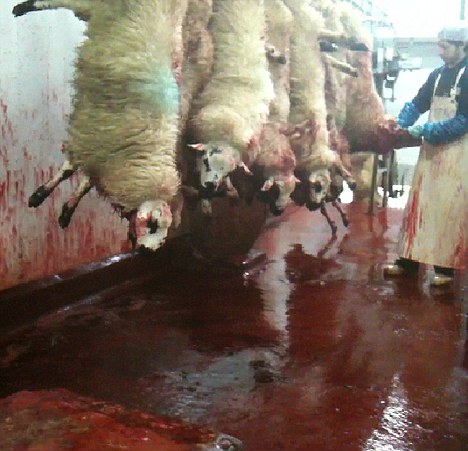
Australian live sheep endure halal torture in a Kuwait livestock market, October 2013
[Source: Animals Australia, ^http://www.banliveexport.com/take_action/kuwait-sheep-sold-illegally/]
.
<< On streets, in backyards and in back rooms at markets, countless sheep, during the Festival of Sacrifice, endure the agony of having their throats cut whilst fully conscious. Often killed by untrained hands, there’s no guarantees of a quick end to their suffering.
In the week leading up to the Festival of Sacrifice, Australian sheep were again found being illegally sold from a notoriously cruel livestock market in Kuwait.
They were destined to be sold to individual buyers for ‘sacrificial’ slaughter.
This very market was the scene of some of the most distressing and confronting cruelty that Animals Australia has ever documented. In 2010 our investigators gathered evidence of sheep being dragged, thrown, trussed and stuffed into car boots, tied onto roof racks and having their throats brutally cut – all while fully conscious.
https://www.youtube.com/watch?feature=player_embedded&v=G0Vmx0n6QYg
‘Strict’ live export rules were meant to protect animals from this fate.
But this is the third time Animals Australia investigators have found sheep in this market. Fourteen months ago we lodged our first complaint with the Department of Agriculture. As a result they imposed additional conditions on the export licences of the three exporters who sent Australian animals into Kuwait.
This footage was taken at Al Rai market in August 2012, and sparked Animals Australia’s first complaint to the Department of Agriculture:
.
.
Despite the additional conditions placed on the exporter, when our investigators returned in February this year, Australian sheep were STILL being offered for sale from this marketplace. A second complaint supported by extensive evidence was lodged and this investigation is still ongoing – nine months later.
Again, in October this year, Australian sheep were still there. This time on the eve of the Festival of Sacrifice – the peak time of animal cruelty and suffering in the region.
Regulations will continue to be disregarded and animals will continue to suffer unless the exporters responsible face severe penalties for breaches. >>
[Source: ‘Sheep suffer as exporters break rules again’, Aussie sheep endure cruel slaughter in Kuwait livestock market, Animals Australia, Oct 2013]
.
<< Sydney-based Halal Certification Authority Australia chairman Mohamed El-Mouelhy, Australia’s leading halal certifier, said it was impossible to stop people in the Middle East slaughtering animals at home or in the street.
“It’s part of the culture, and this is something that everyone has to do to give two-thirds to the poor and one-third they keep,” he said.
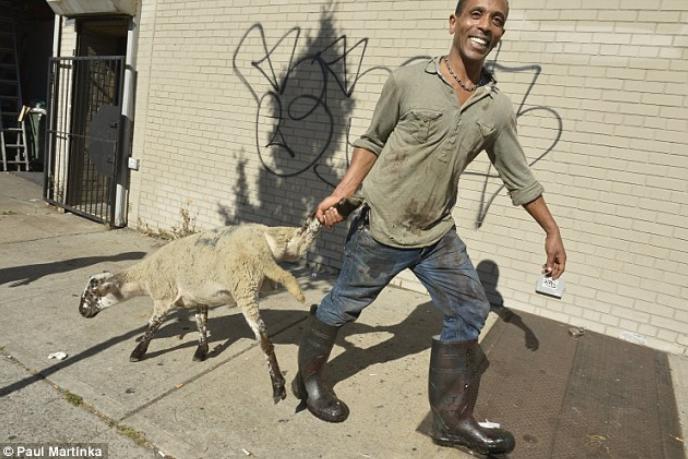
Fahad Saddique, manager of the Al Yasin halal butchery in Sydney’s Lakemba has called on animal-rights activists to show greater religious and cultural tolerance over live exports.
Australia’s Agriculture Minister Barnaby Joyce has conceded cruelty to exported livestock could not entirely be wiped out. Australia’s Prime Minister Tony Abbott says only “very foolish governments” make “policy on the run on the basis of one or two media reports”.
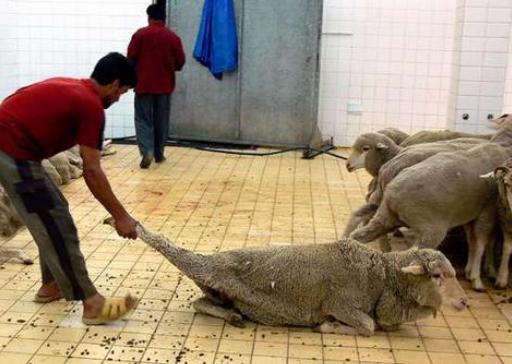
Animals Australia Lyn White said the problem was not religious, but simply about animal cruelty:
“This case is first and foremost about an Australian export company which has broken the law and whose ongoing disregard for Australian regulations in Jordan should attract the strongest sanctions. Australian export requirements permit halal, fully conscious slaughter, but they state that it needs to occur in abattoirs with appropriate infrastructure and trained workers so that the risks of cruel treatment are reduced.
The on-selling of Australian animals to private buyers for slaughter was strictly banned because of the welfare repercussions, especially during religious festivals. Animals Australia said 10,000 Australian sheep were sold outside the current Exporter Supply Chain Assurance Scheme introduced to make exporters responsible for animal welfare throughout the supply chain. >>
.
[Source: ‘Call for cultural tolerance over live exports as activists release film’, by Lauren Wilson, Rachel Baxendale, Jared Owens, The Australian (newspaper), 20131101, ^http://www.theaustralian.com.au/national-affairs/policy/call-for-cultural-tolerance-over-live-exports-as-activists-release-film/story-fn59nm2j-1226750892608]
.
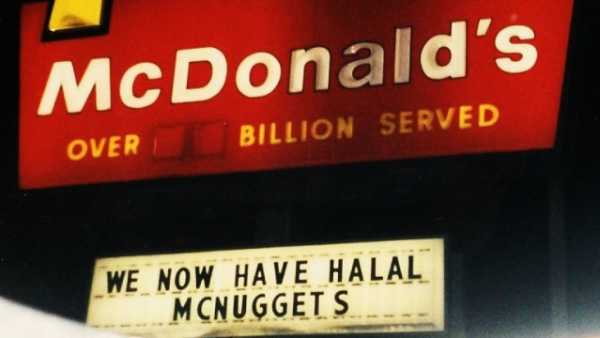 Most chain fast food outlets in Australia now stipulate that only Halal tortured animal meat be served in their stores
Buy Maccas, KFC, Hungry Jacks, Subway, Sumosalad, or any kebab takeaway and so condone halal torturing of livestock animals. Most chain fast food outlets in Australia now stipulate that only Halal tortured animal meat be served in their stores
Buy Maccas, KFC, Hungry Jacks, Subway, Sumosalad, or any kebab takeaway and so condone halal torturing of livestock animals.
.
.
.
Further Reading:
.

.
[1] Animals Australia, ^http://www.animalsaustralia.org/
.
[2] Ban Live Export, ^http://www.banliveexport.com/
.
[3] Get Up, ^https://www.getup.org.au/campaigns/animals/live-export/
.
[4] World Society for the Protection of Animals, ^http://www.wspa.org.au/wspaswork/liveexport/
.
[5] Australian Government’s official encouragement of live animal export, ^http://www.daff.gov.au/animal-plant-health/welfare/export-trade
.
Friday, September 20th, 2013
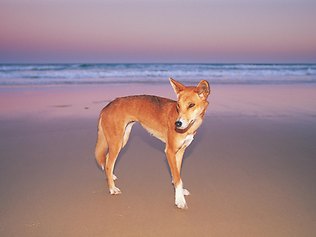
Last Monday 20130916, around 8.30am a native dingo was hit by a vehicle at 18 Mile Beach between Eurong and Dilli Village on Fraser Island. The Island is a World Heritage listed National Park and the wildlife is protected under the Nature Conservation Act.
Distressed witnesses stated the vehicle deliberately changed direction and aimed for the dingo which was struck. The vehicle continued to proceed at speed along the beach. It was described as an Orange Pajero.
The female lay suffering and howling in the sand with her mate close by licking her wounds, a Police Officer was called, who in turn contacted Rangers, sadly, the dingo had to be euthanised.
She appeared to be feeding. The fate of her pups is unknown.
This senseless act of cruelty will hardly cause a stir, there needs to be much stiffer penalties for injuring our wildlife. This is not acceptable.
The School holidays are here, a dingo casualty now, a child could be next.
If anyone has information please contact the local police or QPWS on (07) 4121 1800
Cheryl Bryant. Publicity Officer. Save Fraser Island Dingoes Inc.
 This is an old model Pajero, which may look like the killer’s car
This is an old model Pajero, which may look like the killer’s car
.
[Ed: It is past time that Fraser Island was completely closed to all tourism]
.
Monday, July 8th, 2013
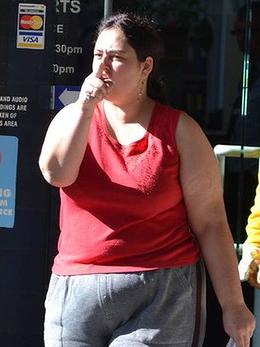 Rosemary Donovan outside Mandurah Magistrate’s Court, Western Australia today Rosemary Donovan outside Mandurah Magistrate’s Court, Western Australia today
after being found guilty of 24 counts of animal cruelty.
[Photo by ABC News]
.
The RSPCA is calling for a West Australian woman to be banned from ever owning animals again after she was found guilty of animal cruelty.
Rosemary Muriel Donovan was charged after RSPCA inspectors visited her residential property in Coodanup, south of Perth, in July 2011.
The inside of the house, where the birds and cats were living, was in a filthy condition. There they found about 80 animals in what the society has described as “seriously appalling conditions” at her residential Coodanup property.
RSPCA inspectors said they found 30 cats in the living room, faeces on the floor and the smell of ammonia so strong that one inspector had to leave the house because he felt sick. Among the animals RSPCA inspectors found an aviary where a rabbit was found walking over dead budgies lying on the floor. Dead guinea pigs were also found on the floor in some of their cages.
Former RSPCA inspector Nat McWhinney said the stench in the house reminded her of a piggery. Another former inspector, Ken Ostle, claimed there were guinea pigs and birds in cages in some bedrooms of the house. He said there were 50 birds and some rabbits in aviaries in the backyard.
The court was told about cats allegedly riddled with mites, fleas and ringworm. Witnesses for the prosecution described a rabbit with an infected eye and another rabbit with wounds.
RSPCA inspectors said the cats had ringworm and fleas, the guinea pig cage had dead animals on the floor, and birds were kept in cages that were too small.
The RSPCA says the animals did not have sufficient food or water. The RSPCA has called for a large fine and a ban on Rosemary Donovan owning any more animals.
Donovan is facing five years in prison or a $50,000 fine after being found guilty of 24 counts of cruelty. She will be sentenced on Friday.
.
[Source: ‘Woman found guilty of 24 counts of animal cruelty’, 20130708, ABC News and local media, ^http://www.abc.net.au/news/2013-07-08/woman-found-guilty-of-animal-cruelty/4806206?section=wa]
.
Friday, June 7th, 2013
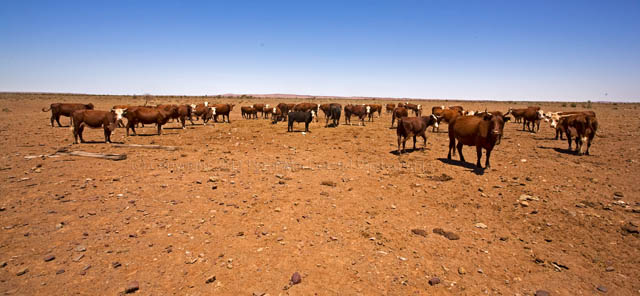 Australian cattle with no pasture, no water, no shade, in baking desert heat.
Typical is the wrath of Northern Australian Cattle Farmers.
Southern Australian Cattle Farmers would never allow this treatment to their prized herds.
Australian cattle with no pasture, no water, no shade, in baking desert heat.
Typical is the wrath of Northern Australian Cattle Farmers.
Southern Australian Cattle Farmers would never allow this treatment to their prized herds.
.
<<The Independent Member for Denison, Andrew Wilkie, has joined Lyn White from Animals Australia ( ^http://www.animalsaustralia.org/ ) to release new footage of cruelty to Australian livestock exported to Egypt and announce another attempt to progress legislation to ban the trade.
Mr Wilkie said his Bill would phase out live exports in three years, as well as immediately impose mandatory stunning of Australian livestock slaughtered overseas.
Mr Wilkie:
“The live export industry is systemically cruel, opposed by the vast majority of Australians and not in our economic interests. This latest evidence of horrific animal cruelty in Egypt demonstrates that this trade will never have appropriate animal welfare outcomes and must be stopped.
I have given formal notice of my intention to introduce the Live Animal Export (Restriction and Prohibition) Bill 2013 into Federal Parliament. A similar Bill was rejected by the Government and Opposition in August 2011. Since then we have seen shocking evidence of more live export cruelty in Kuwait, Pakistan, Israel, Egypt and Indonesia.
It is my hope that the Government and Opposition will now see sense and support the end of this cruel trade.”>>
.
[Source: ‘New footage of cruelty to Australian livestock’, by Andrew Wilkie MP, Independent Member for Denison MR, 20130516, Tasmanian Times, ^http://tasmaniantimes.com/index.php?/article/new-footage-of-cruelty-to-australian-livestock/]
.
.
[Source: Animals Australia, ^http://www.animalsaustralia.org/take_action/cattle-cruelty/]
.
Outback Marginal Grazing is Unviable
.
- Outback Queensland depends upon the inflated outback cost of diesel to freight cattle hundreds of kilometres to abattoirs or to port for live export
- Australia’s native northern has since colonial times been abused, overgrazed, broadscale burned uncontrollably until the savannah has become desert
- Seasonal drought has struck northern Australia’s savannah yet again, like in 2011 and many times prior – nothing new there.
- Greedy cattle farmers have built up excess herds, creating over-supply in cattle at meatworks, meaning cattle prices have plummeted below the cost of getting them to market
- Indonesia’s live export market was always a short term option as Indonesia built its own herds to a point of self-sufficiency – no news there
- Starved cattle stock with visible bony ribs are currently selling for $20 a head at Longreach. It happened before in the 1974 beef crash – no lessons learnt from that.
- Western Queensland land values have slumped and northern and western Queensland stations — like their excess cattle — are virtually impossible to sell
- Australia’s rural sector is now weighed down with $66 billion of combined debt, many cattle farmers are in a debt crisis and marginial equity in properties
- Bankers are now starting to call in debts, especially in the north, triggering a new round of station sales and mortgagee auctions.
- Three of Australia’s biggest cattle companies, Macquarie Agricultural Fund’s Paraway Pastoral, the stock-exchange listed Australian Agricultural Company and North Australian Pastoral Company have already written down the value of their vast portfolios by a combined $80m.
- AACo announced yesterday that fast-falling cattle prices had forced a $43m writedown of the value of its 600,000-head herd.
- The Cattle Council of Australia yesterday warned that this week’s disastrous $20-a-head sale prices had created a critical situation.
- “These prices are indicative of the critical conditions our northern producers are experiencing; unseasonably dry conditions, suppressed market conditions and the continued fallout from the live trade suspension,” CCA president Andrew Ogilvie said. “I fear that the situation will continue to get worse.”
- A survey by rural bankers Rabobank this week reflected widespread fears of approaching drought. It showed 37 per cent of farmers had lost confidence in the future and expect the next year ahead to be tougher than the past 12 months. About one third expect to suffer a fall in income in 2013-14.>>
.
[Source: ‘Drought stalks the land again’, by Sue Neales, Rural reporter, The Australian newspaper, 20130504, ^http://www.theaustralian.com.au/news/nation/drought-stalks-the-land-again/story-e6frg6nf-1226634963784]
.
Ain’t a farmer’s duty to leave a place better than how one found it?
.
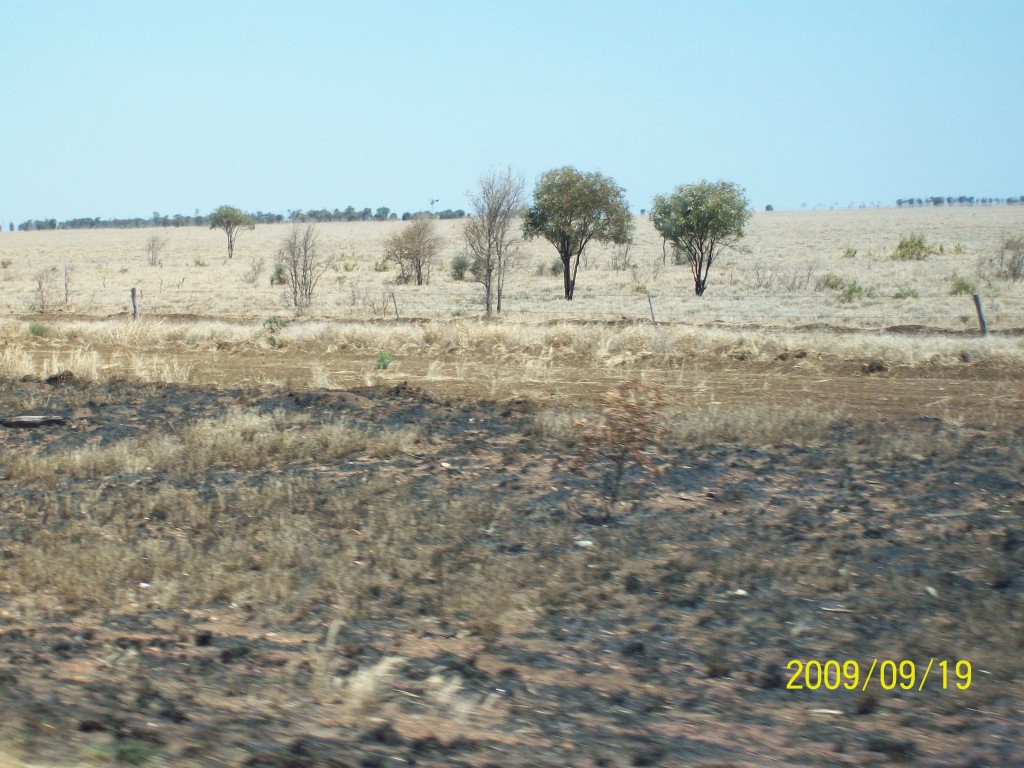 Not looking good.
Generations of Cattle Overgrazing of Australia’s Northern Savannah has decimated it to desert.
It’s similar to the 1930s dustbowlers of the American midwest; farmers abused the land and now they expect charity?
Snap out of the family history dogma.
While you have life and limb, relocate to reliably greener pastures! Not looking good.
Generations of Cattle Overgrazing of Australia’s Northern Savannah has decimated it to desert.
It’s similar to the 1930s dustbowlers of the American midwest; farmers abused the land and now they expect charity?
Snap out of the family history dogma.
While you have life and limb, relocate to reliably greener pastures!
.
[Ed: A previous image here has been removed by us upon becoming aware of its alleged copyright. We obtained the image from the Internet and there were no copyright notices. We noted multiple copies attributable to different sources. Nevertheless we have removed the image immediately and offer our apologies to the owner/s of the image.]
.
Australian Drought Every Decade
.
Australia is subject to seasonal drought commonly at intervals of 11 to 14 years. This has nothing to do with Climate Change theory. Think more El Niño and the varying Pacific Ocean currents and temperatures. The pattern is historically consistent since at least colonisation and probably through millennia.
Major droughts have included 1803, 1809-10, 1813-15, 1826-29, 1835, 1838-39, 1846, 1849-50, 1864-66, 1868, 1877, 1880-86, 1888, 1902, 1911-15, 1918-20, 1937-47, 1965-68, 1982-83, 1991, 1994-2006, 2013.
Australia is the driest continent on Earth. Don’t rural Australian kids get that drummed into them in primary school? Northern Australia’s vast and dry savannah country, inland and west of the Divide is marginal at best for pasture, let alone cropping. Yet after a few bouts of rain, short term memory kicks in. The marginal farmer’s false hope of good timely rain is legendary chronic folklore full of wishful thinking, short term memory loss and denial of Australia’s weather.
.
Occasional rain has become the Marginal Farmer’s Pyrite – fool farmer’s gold.
.
Overgrazing
.
One of the risks associated with arid and semi-arid grazing systems in particular, is land degradation as a result of overgrazing. Overgrazing can be defined as the practice of grazing too many livestock for too long a period on land unable to recover its vegetation, or of grazing ruminants on land not suitable for grazing as a result of certain physical parameters such as its slope.
Overgrazing exceeds the carrying capacity of a pasture. However there may be other factors involved or contributing to apparent overgrazing such as climate change. Overgrazing often results in soil erosion, the destruction of vegetation, and other problems related to these processes.
.
Overgrazing is repeating the US Dustbowl of the ’30s
.
<<Extensive deep plowing of the virgin topsoil of the Great Plains in the preceding decade had displaced the natural deep-rooted grasses that normally kept the soil in place and trapped moisture even during periods of drought and high winds. Rapid mechanization of farm implements, especially small gasoline tractors and widespread use of the combine harvester, were significant in the decisions to convert arid grassland (much of which received no more than 10 inches (250 mm) of precipitation per year) to cultivated cropland.
During the drought of the 1930s, without natural anchors to keep the soil in place, it dried, turned to dust, and blew away with the prevailing winds>>
.
The glut of unwanted cattle is a symptom of an industry run by incompetents. Cattle farmers who put their trust in government and industry big wigs do so at their peril.
.
Australia has only 6% Arable Land
.
<<The Arable land (% of land area) in Australia was 6.14 in 2009, according to a World Bank report, published in 2010.
Arable Land includes land defined by the Food and Agriculture Organization of the United Nations as ‘land under temporary crops (double-cropped areas are counted once), temporary meadows for mowing or for pasture, land under market or kitchen gardens, and land temporarily fallow‘. Land abandoned as a result of shifting cultivation is excluded.>>
.
[Source: ‘Arable land (% of land area) in Australia’, ^http://www.tradingeconomics.com/australia/arable-land-percent-of-land-area-wb-data.html]
.
.
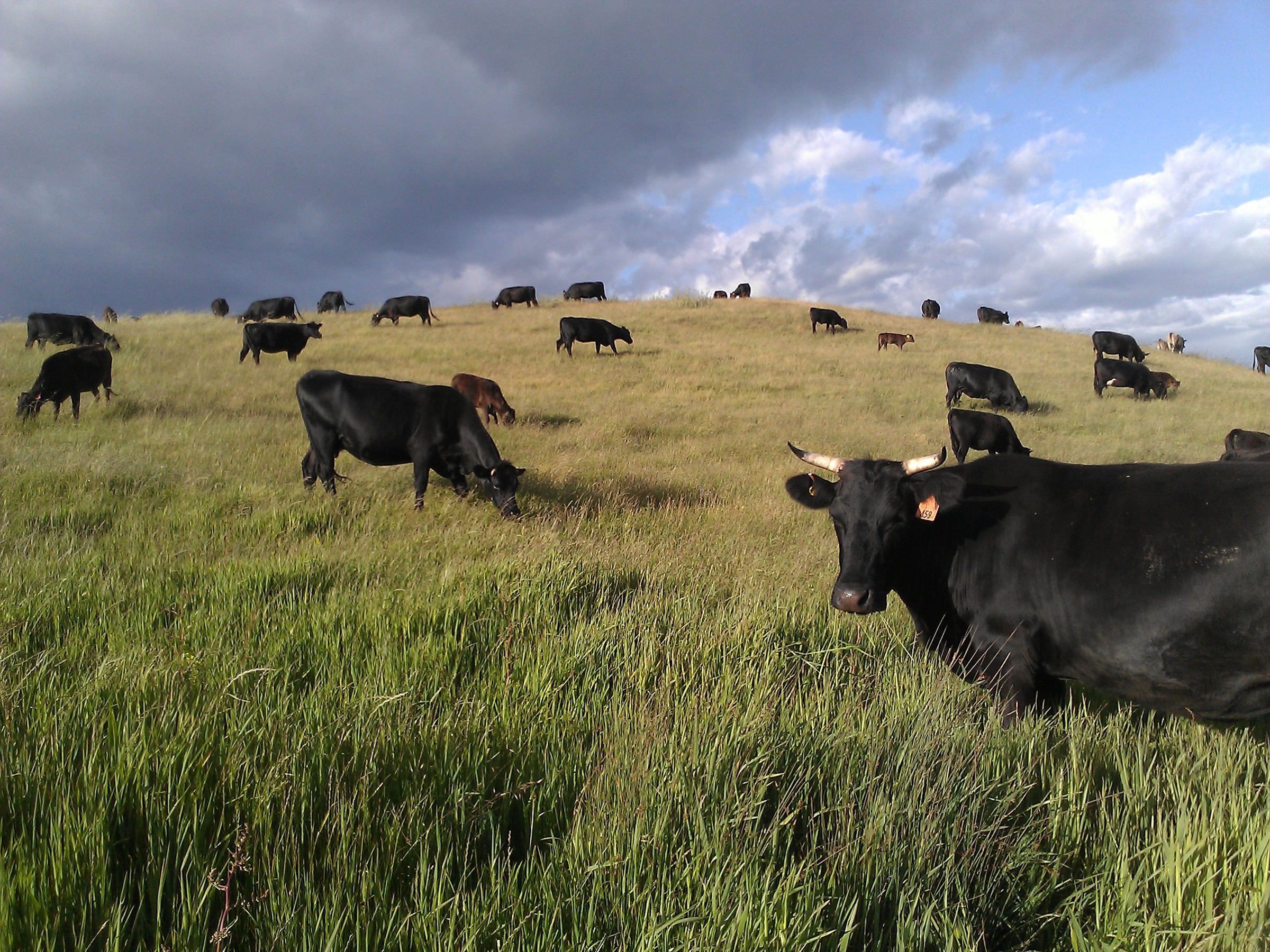 Prime Australian Country for Waygu Beef
Read: ^http://wagyu.une.edu.au/]
Prime Australian Country for Waygu Beef
Read: ^http://wagyu.une.edu.au/]
.
Case Study of Good Rainfall and Sustainable Location
.
Corumbene Brangus Cattle
.
<<At Corumbene Brangus we are dedicated to producing the type of stock that you would be proud to have in your herd. We have taken the time to assess, improve and adapt our breeding herd to the Southern Australian climate and producing cattle of distinction and character that we love.
Our property is situated in the Western District of South West Victoria. We have a high average rainfall of about 30″, with temperature ranging from mid 40’sC (104 Fahrenheit) in summer to low minus in winter. Our pastures are predominately rye and clover kept productive with an extensive pasture renovation and soil conditioning program.
Corumbene Brangus cattle are raised solely on these healthy pastures. Brangus cattle are known for their ability to excel on pasture alone with early finishing and easy fleshing ability no matter what season or time of the year, in all our weather extremes. We calve down during Spring (August-October) each year.>>
.
[Source: Corumbene Brangus, ^http://www.corumbenebrangus.com/cattle.htm]
.
Observations about MLA’s herded strategy for Northern Australia
.
1. Putting all cattle into a single export market to Indonesia is poor strategy – remember that proverb, don’t put all your eggs in one basket – what action has been taken to develop other export markets?
2. Indonesia has long indicated to Australia that it is breeding towards self-sufficiency in its own live cattle supply, so the decrease in live cattle demand was on the cards, to eventually dry up.
3. Northern Australia’s drought and flood cycle is not new. Farmers must have been aware of the likelihood of drought following the floods of the past four years, so why risk excessive stock?
4. Poor quality control of live export to ensure Australian standards were being met was slack. The strategic risk of discovery of cruel abuse of cattle by an Indonesian abattoir was high. So given that risk, the Meat and Cattle Association (MLA) should have been proactive and diligent in ensuring such abuse was not possible. When abuse is systemic it is only a matter of time before it would be publicly exposed. And the likely consequences of a trade shut down would be been reasonably forseeable.
5. Aside from the above live export has an ongoing record or cruelty and abuse under industry self regulation. So it is always going to be high risk from a social stakeholder perspective. Those who live by the sword…
6. In Australia, in any industry – media, agriculture, mining, forestry- self-regulation never works to the standard expected of Australian society.
.
We have no sympathy for the industry. May the northern Australian cattle industry linked to live trade go bankrupt as it morally deserves.
.
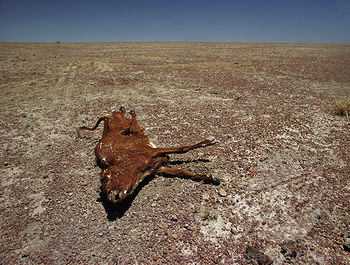 Once a farmer can inflict such upon his stock, he possesses such evil to do so the same to his children
Once a farmer can inflict such upon his stock, he possesses such evil to do so the same to his children
Criminal bastardry deserves criminal justice.

<<She won’t mind if the place we stand is marked by ash.
She believes what doesn’t kill her only takes more time to kill her.
Then she smiles as she paints her lips and does her lashes.
Stunning as a taxidermy victim in a silver cage.
I’m arrested by an aria brought from the country.
Stuck in dumb amazement like a dog who’s told to levitate.
This smash number-one goes to her lover in the belfry,
Singing like a bird in flames and headed for the window pane.
In the coming years, let’s try and milk a fortune off them.
I think we’re qualified by now.
Alouette, gentille alouette.
Head to toe so thoroughly until we’re both dismembered.
Alouette, gentille alouette.
Naá¯ve, yes, but none the worse, spinning glue back into horses.
I’ll never leave the place where you are.
Hand-in-hand into a rented car.
Merrily into the abattoir.
Spilling out all over, I’ll be Noah on the storm.
And two-by-two in love we’ll speed back into bed and never leave it.
In the coming years, let’s try and milk a fortune off them.
I think you’re qualified by now.
Alouette, gentille alouette.
Head to toe so thoroughly until we’re both dismembered.
Alouette, gentille alouette.
Naá¯ve, yes, but none the worse, spinning glue back into horses.
Alouette, gentille alouette.
Head to toe so thoroughly until we’re both dismembered.
Alouette, gentille alouette.
Alouette, gentille alouette.>>
.
[Source: The Pernice Brothers’, Cruelty To Animals’]
.
[Ed: My father’s family heritage was sheep farming in Victoria’s west dry marginal Wimmera and our sheep farming roots extended back to 18th Century England. That tradition ended under tragic circumstances near Stawell in 1942; yet in hindsight, subsequent generations of our family are far better for it. Relocating takes more guts than putting up. Honour is more deserving of our future generation; the oldies should understand.]
.
Tags: animal cruelty, Australian Agricultural Company, Australian livestock, Cattle Overgrazing, Egypt, El Niño, Indonesia, Indonesian abattoirs, Indonesian torture of Australian Cattle, Israel, Kuwait, live cattle trade, Marginal Farmer's Pyrite, Meat and Livestock Association, North Australian Pastoral Company, Northern Australian Savannah, Pakistan
Posted in 53 Animal Welfare!, Threats from Farming | 1 Comment »
Add this post to Del.icio.us - Digg
Tuesday, December 11th, 2012
Australia’s live animal trade cannot be trusted. Animal cruelty offence after offence ignored by Meat and Livestock Australia (MLA) has become recidivist.
This organisation has not only neglected the welfare of Australian animals to slaughter time and again, it has sacrificed the standards of the Australian industry it supposedly represents.
Australian farm animals are being shipped live overseas to be tortured by cultures below Australian morality.
Australia’s entire live export industry needs to be shut down for it systemically being complicit in persistent animal cruelty and immorality.
If that means Australian participating farmers and their families go broke, so be it. Australian farmers complicit in this immoral, unscrupulous and unaccountable trade are unworthy of profiting from it. They are no better than those of previous centuries who profitted out of the misery of the human slave trade or the child sex trade.
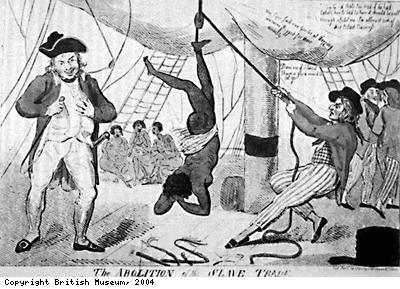
Australia’s Minister for Agriculture, Fisheries and Forestry, Senator Joe Ludwig, ultimately responsible needs to be sacked for recklessly presiding over repeated Australia’s agricultural trade immorality and for his gross incompetence in failing to address systemic animal cruelty for now years.
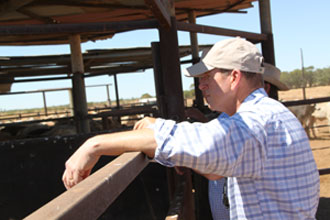 Senator Joe Ludwig’s legacy of prevailing over an immoral trade and doing nothing but allow it to perpetuate Senator Joe Ludwig’s legacy of prevailing over an immoral trade and doing nothing but allow it to perpetuate
The entire Meat and Livestock Australia Board of Directors needs to be sacked:

- Chairman, Robert Anderson
- Managing Director, Scott Hansen
- Director, Michelle-Allen
- Director, Lucinda Corrigan
- Director, Greg Harper
- Director, Christine-Gilbertson
- Director, Geoff-Maynard
- Director, John-McKillop
- Director, Peter Trefort
- Director, Rodney-Watt
.
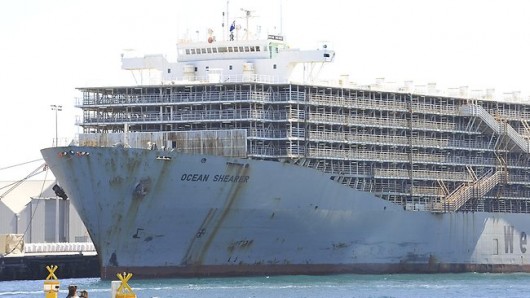 Dodgy Ships, Dodgy Trade Dodgy Ships, Dodgy Trade
.
WARNING: THE FOLLOWING VIDEOS CONTAIN IMAGES OF ANIMAL CRUELTY
.
‘Indonesian torture of Australian Cattle in June 2011’
.
http://www.youtube.com/watch?feature=player_detailpage&v=wQuj3X5iRyw
.
.
‘Shocking undercover live export investigation: Tnuva, Israel‘
http://www.youtube.com/watch?feature=player_detailpage&v=yF4Qz9MY8ek
.
.
‘2011 Video shows cattle cruelty’
[Source: ‘Video shows cattle cruelty’, by Richard Willingham, The Age newspaper, 20110825, ^ http://www.theage.com.au/national/video-shows-cattle-cruelty-20110824-1jab6.html]
.
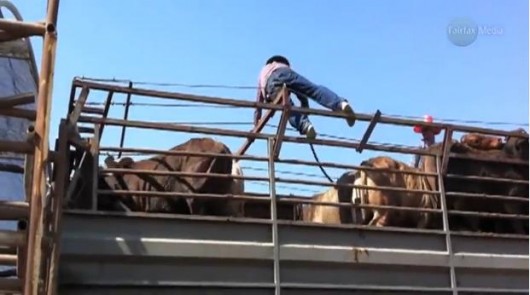 Click Above Image to link to site to watch video Click Above Image to link to site to watch video
.
<<New vision obtained by Fairfax appears to show cruelty to cattle in Israel, one of the countries to which Australia exports its livestock.
Fresh evidence of cruel treatment of Australian livestock in foreign markets has raised new doubt about the ability of the government and industry to ensure the welfare of animals exported for slaughter.
Footage obtained by The Age shows filth-covered cattle being belted with spike-tipped poles as they are unloaded from a cramped truck in Israel. More than 43,000 cattle were exported there in 2010.
It comes as cattle exports to Vietnam are about to resume after a seven-year break, raising concern among Labor backbenchers and Animals Australia because of Vietnam’s animal welfare record.
An image taken from the video appears to show cattle being belted with spike-tipped poles.
The film, shot by Israeli group Anonymous for Animal Rights on August 12, shows cattle covered in faeces after their long boat voyage. ”It was quite obvious that the handlers had no training at all, and that the poles had nails or something sharp on the end,” spokeswoman Hila Jerem said.
While the footage is not as confronting as that from Indonesia, welfare groups say it is further evidence of how little Meat & Livestock Australia (MLA) know about foreign markets but are still willing to promote exports to them….>>
.
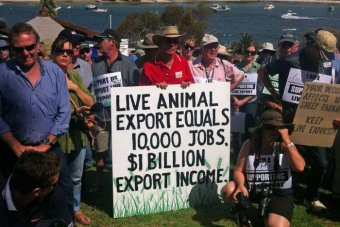 Immoral Trades are Not Worth a Cent
Some would sell their children for money too. Immoral Trades are Not Worth a Cent
Some would sell their children for money too.
.
 The immoral, illegal Sex Trade still flourishes in some countries too. The immoral, illegal Sex Trade still flourishes in some countries too.
.
Thursday, November 15th, 2012
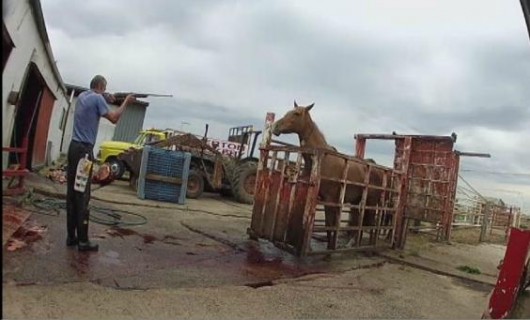 We shoot horses, don’t we?
2012: An Australian shooting a beautiful, intelligent, strong, healthy horse
..just because humans decided that this horse is unprofitable for human exploitive purposes: We shoot horses, don’t we?
2012: An Australian shooting a beautiful, intelligent, strong, healthy horse
..just because humans decided that this horse is unprofitable for human exploitive purposes:
…Horse Racing!
.
 Horses exploited for gambling Horses exploited for gambling
.
Introducing The Knacker
.
The Knacker is a person in the trade of rendering horses unfit for human consumption, such as horses that can no longer work. This leads to the slang expression “knackered” meaning very tired, or “ready for the knacker’s yard”, where old horses are slaughtered and made into dog food and glue.
But across Australia, it is not just old horses, but unwanted horses, that are being carted to be slaughtered.
.
Complicit Melbourne Knackeries – worth a peak
(‘Horse Death Camps’ – they arrive not knowing what will become of them, and are slaughtered)
.
- Laverton Knackery, 88-98 Leakes Road, Laverton, Victoria, 3028
- Yarra Glen Knackery, 28 Melba Highway,Yering Victoria, 3770
- Dandenong Knackery, 10 Cahill Street, Dandenong, Victoria, 3175
- Ballarat Knackery, Finch’s Road, Smythes Creek, Victoria, 3351
.
With four knackers serving Melbourne, demand from the Victorian Horse Racing Industry must be significant.
 . .
.
‘Moral Universalism’ v ‘Ethical Dilemma’ – ‘Horse Racing’ couldn’t give a…
.
Such primitive and exploitative attitudes toward animals need changing.
‘Putting down‘ a health animal is euphemistic involuntary euthanasia. But such slaughter is inflicted by humans not just upon horses, but upon the entire animal kingdom.
This is what the Nazi’s did to many humans – supposed ‘subhumans’ were judged unworthy of living because they didn’t suit their standards and purpose. It was eupemistically called ‘Eugenics‘.
But what is the moral difference between Nazi selective extermination of unwanted humans and the Horse Racing Industry’s selective extermination of unwanted horses?
Humanity’s treatment of animals remains rationalised nazism, and rationalising is so dangerous that it can make a moral person commit immoral and amoral acts.
.
“Your ability to rationalise your own bad deeds makes you believe that the whole world is as amoral as you are.”
~ Douglas Coupland
.
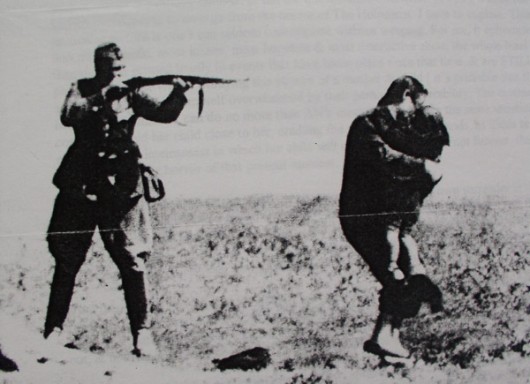 ‘Murder’ or ‘being put down’?
Clearly this is a case of ‘Moral Universalism’ – a gross evil wrong and a disturbing image agreed by all humanity.
It is not a mere ‘Ethical Dilemma’.
Yet 21st Century societies continue to rationalise the exact same treatment of animals as ‘being put down’
and so regarded by the mainstream populous as a mere ‘Ethical Dilemma’.
Complexity is no excuse.
This is rationalised, reinforced, conditioned and ultimately cultural. ‘Murder’ or ‘being put down’?
Clearly this is a case of ‘Moral Universalism’ – a gross evil wrong and a disturbing image agreed by all humanity.
It is not a mere ‘Ethical Dilemma’.
Yet 21st Century societies continue to rationalise the exact same treatment of animals as ‘being put down’
and so regarded by the mainstream populous as a mere ‘Ethical Dilemma’.
Complexity is no excuse.
This is rationalised, reinforced, conditioned and ultimately cultural.
.
<<As long as there have been men on the earth, the struggle between man and the subhuman will be the historic rule; the Jewish-led struggle against the mankind, as far back as we can look, is part of the natural course of life on our planet. One can be convinced with full certainty that this struggle for life and death is just as much a law of nature as is the struggle of an infection to corrupt a healthy body.>>
~ Reichsführer-SS Heinrich Himmler, 1935
The year 1935 was only 77 years ago. Nazi persecutions in Germany were then deliberately and systemically rationalised, reinforced, conditioned and ultimately became cultural across mostly an entire population.
.
Philosophical Quandary:
.
.
Compare the above with:
.
.
The Horse Racing Industry is exploitative of horses and immoral towards horses. It engages in horse eugenics, which is immoral.
Horses are intelligent sentient beings. Barbaric practices belong to past centuries. The 21st Century is an advancement beyond past barbarism.
Moral Sense Test: If what is allowed to horses ought to be allowed to human children.
The following television programme aired last night (20121114) on the Australian Broadcasting Corporation reveals the barbaric truth of the exploitative and murderous operations within the Racing Industry in Australia. It reveals that many horses are bred for the Racing Industry, but also that many horses are murdered like fodder.
.
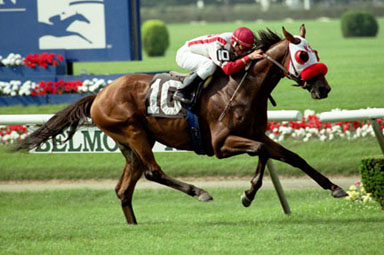 The exciting public image of Thoroughbred Racing The exciting public image of Thoroughbred Racing
.
‘What happens to failed racehorses?”
.
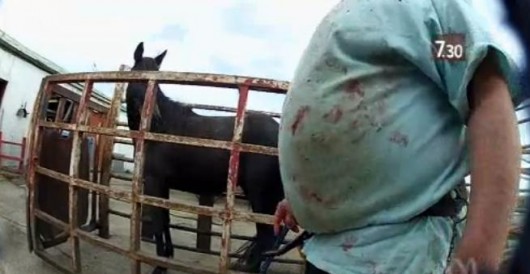 What are you going to do to me? What are you going to do to me?
.
 Others profit from gamblers on horse racing Others profit from gamblers on horse racing
.
.
WARNING: The following material includes morally disturbing images/scenes that are highly inappropriate for children to view.
These images/scenes are included in this article in the pursuit of challenging the immorality of prevaling 21st Century cultural reality.
.
.
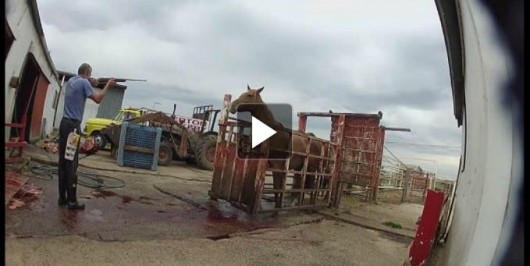 More than 8,000 bred racehorses a year throughout Australia are murdered for dog food
Click image to replay ABC programme:
‘What happens to failed racehorses?’
[Source: ‘What happens to failed racehorses?’, by Guy Stayner (reporter), Australian Broadcasting Corporation, 20121114,
^http://www.abc.net.au/7.30/content/2012/s3632985.htm] More than 8,000 bred racehorses a year throughout Australia are murdered for dog food
Click image to replay ABC programme:
‘What happens to failed racehorses?’
[Source: ‘What happens to failed racehorses?’, by Guy Stayner (reporter), Australian Broadcasting Corporation, 20121114,
^http://www.abc.net.au/7.30/content/2012/s3632985.htm]
.
<<Owning a racehorse is promoted as an easy way to amass fame and fortune, but very few win any money at all let alone return their training costs and/or purchase price.
When a thoroughbred destined for racing is born in Australia, its chances of being a successful racehorse are slim. It is estimated that only 300 out of every 1000 foals produced will ever start in a race.
.
That means of the 18,000 thoroughbred foals born each year in Australia alone, an average of 12,600 will be ruthlessly discarded and mostly end up at “the doggers.”
.
Of the horses that do race, one Australian Study found that approximately 40% earned no money at all and only 13% earned enough money to cover costs. These figures did not include the initial purchase price. Dr Paul O’Callahan, Chief Veterinary Steward of the Victorian Racing Club states that approximately less than 2% of horses actually earn their keep.>>
.
Breeding
.
While the racing industry argues that many ex-racehorses are sent to stud for breeding, the number of horses involved in breeding has been in steady decline for many years. Since 2000, the number of breeding mares has declined by 12% while stallions have decreased by 30%. That means that for every horse that is sent to stud, at least one leaves. Nearly all the horses that leave the stud will be killed for dog food.
.
Riding Schools, Private ownership
.
Unfortunately, saving ex-racehorses from euthanasia often condemns them to a worse fate, in a downward spiral of abuse and neglect. Few members of the public have the expertise to care for and handle horses properly, let alone understand how much they eat and how expensive it is to feed even one horse, especially during droughts or where the availability of good quality land for agistment is limited. In these situations a horse may have to be fully handfed. Many horses bought as ‘paddock ornaments’ end up totally neglected and left to starve as a result. Horses sold to riding schools or trail riding clubs can lead a miserable existence of hard work, improper care and insufficient feed.
.
‘But a humane and kind retirement for racehorses in some Elysian field (pagan paradise) is largely an urban myth.’
.
A few lucky ones!
.
There is no doubt there are a few lucky horses that are saved by caring individuals and horse rescue shelters. Unfortunately, the numbers are extremely low due to the expensive costs and the time needed in retraining and maintaining a horse. An average healthy horse costs in excess of $4,000 per year.
.
The Doggers and Abattoirs
.
In a business where making a profit is extremely difficult, it is vital to discard a horse as soon as possible after deciding it is no longer viable. To facilitate this, many trainers have arrangements with transport contractors, knackeries or abattoirs that pick up horses on demand. The horses are often picked up at discreet times to spare track workers, strappers, trainers and owners from the guilt of this sad reality.
Younger horses will generally be killed for human consumption in one of Australia’s 2 horse abattoirs located in Caboolture, Queensland and Peterborough, South Australia. Older horses generally end up as dog (food).>>
.
For more information: Search Google Terms: ‘Horse Slaughter‘, ‘Horsemeat: The Facts‘
.
‘Wastage’ – the ‘bycatch‘ of Horse Racing
.
 Unwanted Race Horse on Death Row at the Knackery Unwanted Race Horse on Death Row at the Knackery
.
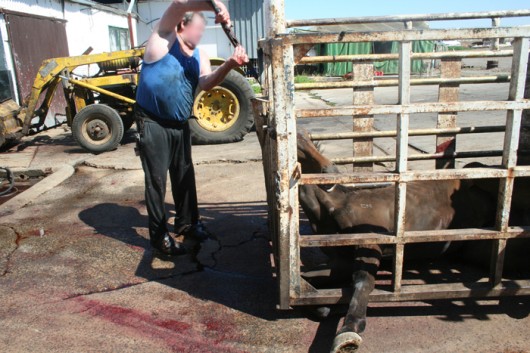 Unwanted Race Horse being murdered at the Knackery Unwanted Race Horse being murdered at the Knackery
.
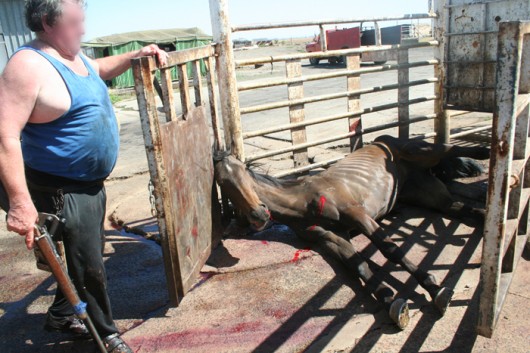 Murdered Race Horse at the Knackery Murdered Race Horse at the Knackery
.
[Source: The Coalition for the Protection of Race Horses – website, ^http://www.horseracingkills.com/the-issues/wastage/]
.
The Media Glamour of Horse Racing
.
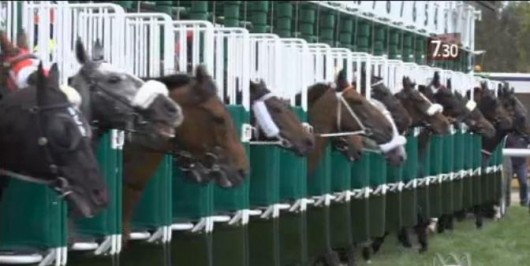 Horse Racing is Immoral – no question Horse Racing is Immoral – no question
Horse Racing breeds, genetically modifies, exploits, then slaughters horses only so that humans can gamble.
Horse Racing is not a sport, just as Cock Fighting and Badger Baiting are clearly not sports.
True Sport is a fair contest involving human physical exertion.
Animal use is not sport but exploitation.
Never bet on a horse race in respect to horses on principle
.
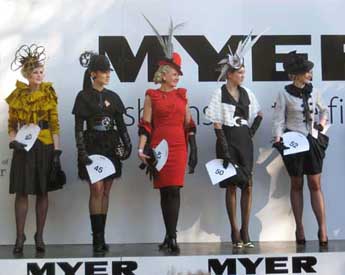 Victorian Racing’s Oak’s Day Fashion
Part of the promotion of race going
…as ethical as wearing fur coats Victorian Racing’s Oak’s Day Fashion
Part of the promotion of race going
…as ethical as wearing fur coats
.
 No shortage of profiteers from gamblers on horse racing No shortage of profiteers from gamblers on horse racing
.
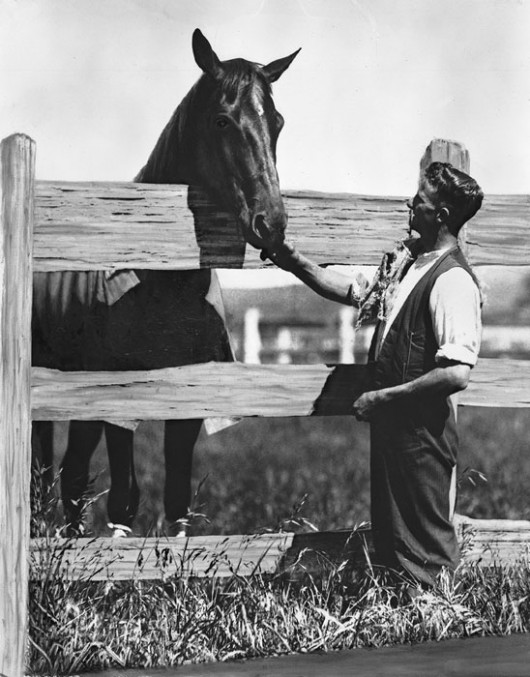 New Zealand’s Pharlap was poisoned by Americans
Read the True Story: ^http://www.pharlap.com.au/thestory/
[Copyright © 2012 Equus Marketing Pty. Ltd] New Zealand’s Pharlap was poisoned by Americans
Read the True Story: ^http://www.pharlap.com.au/thestory/
[Copyright © 2012 Equus Marketing Pty. Ltd]
.
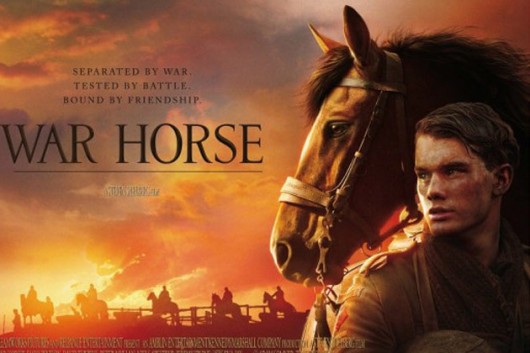 Remember what happened to thousands of horses in World War I?
[Source: Click link to play Movie Trailer > ^http://www.youtube.com/watch?v=B7lf9HgFAwQ&feature=relmfu] Remember what happened to thousands of horses in World War I?
[Source: Click link to play Movie Trailer > ^http://www.youtube.com/watch?v=B7lf9HgFAwQ&feature=relmfu]
.
.
Further Reading:
.
[1] Coalition for the Protection of Race Horses
^http://www.horseracingkills.com/
.
[2] ‘What happens to failed racehorses?‘
Television programme by Guy Stayner (reporter), Australian Broadcasting Corporation, 20121114, ^http://www.abc.net.au/7.30/content/2012/s3632985.htm]
.
Programme Transcript:
.
<<LEIGH SALES, PRESENTER: The Spring Racing Carnival this year has been dogged by claims of corruption and skulduggery, but there’s another ugly underside to the so-called “sport of kings”. 7.30 has obtained video of failed racehorses being shot for pet food, a fate suffered by thousands of horses around the country each year.
Guy Stayner reports, and a warning: this story contains images of horses being put down.
GUY STAYNER, REPORTER: The dust has hardly settled on the Spring Carnival and the images of Green Moon’s Melbourne Cup victory and the Royal presentation will be replayed for decades.
But this is the video the industry would prefer you didn’t see. Horses walking into the killing box for their meeting with the rifleman. This is Cup Week at the knackery.
WARD YOUNG, COALITION FOR THE PROTECTION OF RACEHORSES: The racing industry can’t possibly stand up and say that they love these horses and then the next day when they can no longer earn money on them, send them to the knackery where they will receive a bullet in the head and be killed for dog (food).
GUY STAYNER: The shooting of horses at the Melbourne knackery was secretly filmed by animal activists. Industry insiders estimate 10,000 race horses a year are slaughtered. The majority are used for pet food and horse sales around the country are attended by meat buyers.
At the Echuca sales this month about 100 horses were sold at auction, including failed race horses.
JOHN MOYLE, AUCTIONEER: Lot’s of those horses, contrary to what a lotta people think, actually go to homes and people will test their skills at educating them, breaking them in, using them as a kids’ pony.
GUY STAYNER: The sales can still become a dumping ground for race horses. This obviously injured horse was listed for sale at Pakenham last week.
???: A lot of people just don’t care. Like, they don’t wanna put the money into fixing them.
GUY STAYNER: There were currently about 15,000 thoroughbred foals born every year. The industry calls the number of horses lost to racing each year “wastage”.
Is the so-called issue of wastage a problem for racing?
HUGH WIRTH, RSPCA: A big, big problem and we don’t know how bad it is, but we suspect it’s very bad. We are breeding lots and lots and lots of horses. Some of them fall by the wayside for things that should never happen and that causes wastage.
GUY STAYNER: So is the racing industry breeding too many horses?
HUGH WIRTH: Absolutely.
GUY STAYNER: While the Clydesdale cross can sell for thousands of dollars in the main ring, race horses in the rear saleyards only fetch a couple of hundred.
RACHEL BEATSON, HORSE RIDER: The breeder came up to me and had a chat to me and he said, “She raced a week ago in Wodonga and came 1,400 metres behind last place.” She’s pretty slow. She’s not born to be a race horse.
GUY STAYNER: Not fast, but this horse was very lucky.
RACHEL BEATSON: I knew I had to take her home. She was just gorgeous.
GUY STAYNER: What would’ve happened to this horse if you hadn’t have … ?
RACHEL BEATSON: Dog meat. The dog meat man was bidding against me and I just – I said, “I’m gonna keep going so you might as well stop, buddy.” Yeah.
GUY STAYNER: So what did she cost you?
RACHEL BEATSON: $300. Not much at all.
GUY STAYNER: But finding a new home for a thoroughbred is easier said than done. They cost between $50 and $100 a week to keep and are often difficult to handle.
BILL SAUNDERS, HORSE TRAINER: A lot of horses are quite frazzled by racing and you find that they quite often need two or three months just to sort of come down out of the clouds and eat some grass and generally get used to being a horse again.
GUY STAYNER: Bill Saunders runs a race horse retraining program west of Melbourne. He’s found new homes for 50 former race horses in the past two years.
BILL SAUNDERS: Some of them are quite badly injured or, you know, really difficult in the head in terms of being quite mad, and those horses are probably better off put down. But of the ones that are left, there are many, many that are very suitable riding horses and of course many of them do go out and do exactly that.
GUY STAYNER: While it’s difficult enough to rehome a race horse, about a third never even reach the track.
HUGH WIRTH: Something like 8,500 horses at an early age are excluded from the racing industry. Usually due to injury – mostly due to injury. Mostly due to the fact that they were prepared for racing when they were juveniles and not mature in bone and limb. That’s the big problem for the racing industry.
WARD YOUNG: The racing industry needs to realise that by breeding these animals and by profiting from them while they’re racing and having those sort of benefits, they owe a responsibility to that animal to look after it for its entire life, not just its life while racing.
GUY STAYNER: Racing Victoria admits there is room for improvement and is considering an owners’ levy as part of a new strategic plan on race horse welfare.
BILL SAUNDERS: We have many owners here who’ve actually been prepared to pay money to get their horses retrained in order to give them a good home. Unfortunately it’s not as widespread as I would like it to be.
RACHEL BEATSON: (To horse) We’re gonna be buddies, we’re gonna be buddies.
LEIGH SALES: Guy Stayner reporting. >>
.
[3] Ban Jumps Racing
^http://banjumpsracing.com/blog/tag/steeplechase-race/
.
[4] Animal Aid
^http://www.animalaid.org.uk/h/n/CAMPAIGNS/horse/
.
[5] Racing Victoria
^http://www.racingvictoria.net.au/
.
[6] The Scale of the Horse Meat Issue
^http://en.wikipedia.org/wiki/Horse_meat
.
In 2009, a British agriculture industry website reported the following horse meat production levels in various countries:
Horse meat production levels (2009)
| Country |
Tons per year |
| Mexico |
78,000 |
| Argentina |
57,000 |
| Kazakhstan |
55,000 |
| Mongolia |
38,000 |
| Kyrgyzstan |
25,000 |
| Australia |
24,000 |
| Brazil |
21,000 |
| Canada |
18,000 |
| Poland |
18,000 |
| Italy |
16,000* |
| Romania |
14,000 |
| Chile |
10,000 |
| France |
7,500 |
| Uruguay |
8,000 |
| Senegal |
9,500 |
| Colombia |
6,000 |
| Spain |
5,000* |
- * Including donkeys.
[Source: ‘ Argentina-Horse Meat world production figures‘, Farming UK, 20090117, retrieved 20110304]
.
[Ed: A horse weighs up to about 500kg, so for every 1 ton, two horses were slaughtered; so according to the above statistics in Australia’s case 48,000 horses were slaughtered in 2009 for horse meat.
.
Animal Activists are brave moral champions exposing the immoral barbaric reality of our forebears, and are to be applauded for doing so.]
.
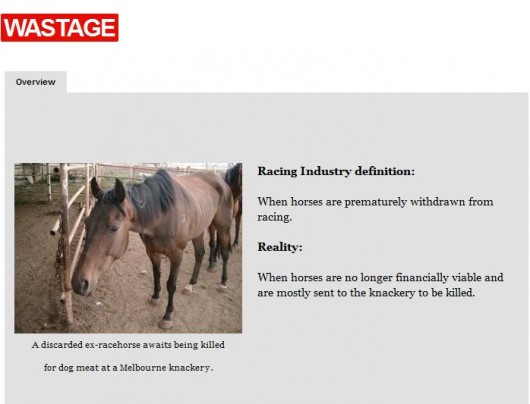 . .
Tags: animal rights, animal welfare, Badger Baiting, Cock Fighting, dog food, dog meat, Ethical Dilemma, eugenics, horse eugenics, horse meat, horse murder, horse racing, knackery, Melbourne Cup, Moral Absolutism, moral relativism, Moral Universalism, morality test, Murder, putting down, race horses, rationalise, shooting horses, Steeple Chasing, Thoroughbred Racing, True Sport
Posted in 53 Animal Welfare! | No Comments »
Add this post to Del.icio.us - Digg
Tuesday, November 6th, 2012
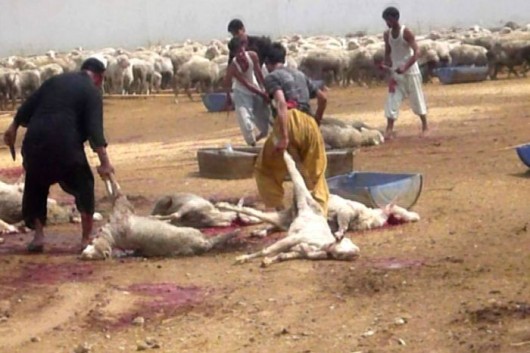 Pakistani animal handling barbarism – business as usual Pakistani animal handling barbarism – business as usual
Australia’s Agriculture Minister claims the latest Pakistani incident is (unlike Indonesia) isolated and so he is ‘comfortable’?
.
Australia’s Agriculture Minister, Senator Joe Ludwig, says Australia’s live export program works well and will continue, despite the brutal culling of up to 10,000 Australian sheep in Pakistan in recent weeks.
Senator Ludwig said his department would conduct a full investigation into the latest animal welfare incident, in which thousands of Australian sheep were clubbed, stabbed and buried alive in the town of Karachi on suspicion they were diseased with anthrax and salmonella.
“(Live exports) continues to be a very good trade for Australia. It continues to support jobs and opportunity in rural Australia, it continues to provide employment. All of that means that it is an effective trade and quite a good trade,” Senator Ludwig told ABC radio.
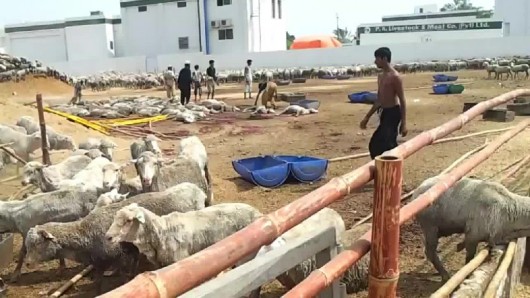 Middle East profitable markets for Australian Sheep – no wonder! Middle East profitable markets for Australian Sheep – no wonder!
Video has emerged of thousands of Australian sheep being brutally culled in Pakistan with the export company that transported the animals, Wellard, describing it as “disturbing”.
A total of 21,000 sheep arrived in Karachi earlier this month after they were given a positive health check by Pakistan and Australian government officials. They were originally destined for Bahrain but were rejected by the Arab kingdom after they were found to have the common scabby mouth disease.
Local authorities in Karachi said the culling of up to 10,000 sheep was ordered because (they claimed) the animals had salmonella and anthrax.
The owner of the sheep PK Livestock has lodged a court injunction to prevent the remaining animals being killed and a ruling on their future is due to be handed down today.
The owner, and Australian officials, have questioned the finding that the animals were diseased.
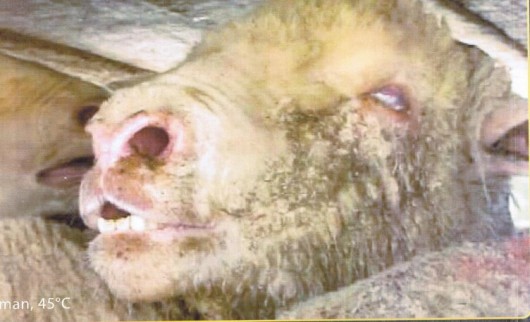 2007: Australian Sheep dying under 45 Degrees Celsius under Oman sheep traders 2007: Australian Sheep dying under 45 Degrees Celsius under Oman sheep traders
.
Paul Morris, acting deputy secretary of the Department of Agriculture, Forestry and Fisheries, said this morning if the animals had been infected with anthrax they would have died within 48 hours and so any potential disease could not have come from Australia.
“From our view point when the animals left Australia they were perfectly healthy, they certainly had no major diseases,” Mr Morris told ABC radio.
“When they arrived in Bahrain and even before that when they were offloaded in Oman there were certainly no issues. We had a vet on board all the way through who was checking the health and the animals seemed fine throughout the voyage.
“If they did have anthrax they would have died or they would have contracted it in Pakistan rather than during the voyage or before they left Australia.”
.
[Source: ‘Appalling’ sheep cull in Pakistan won’t halt trade, says Joe Ludwig’, by Lanai Vasek, The Australian (national newspaper), 20120928, ^http://www.theaustralian.com.au/national-affairs/appalling-sheep-cull-in-pakistan-wont-halt-trade-says-joe-ludwig/story-fn59niix-1226483226375]
.
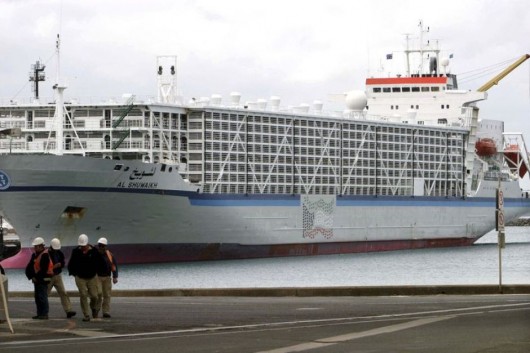 Portland – Australia’s hub of Agricultural Immorality Portland – Australia’s hub of Agricultural Immorality
.
Australian Agriculture – live up to Australian moral standards!
Since industry self-regulation can’t be trusted, ban all live animal export!
.
.
Further Reading:
.
[1] ‘Another Bloody Business‘, by Sarah Ferguson and Deb Masters (investigative journalists), Australian Broadcasting Corporation, Four Corners Programme (TV), 20121107, ^http://www.abc.net.au/4corners/stories/2012/11/02/3623727.htm
.
[2] ‘Live Animal Export Indefensible‘, Animals Australia, ^http://liveexport-indefensible.com/
.
[3] Animals Australia main website, ^http://www.animalsaustralia.org/
.
[4] Australian Government principles on Live Animal Export, Department of Agriculture, Fisheries and Forestry, ^http://www.daff.gov.au/animal-plant-health/welfare/export-trade
(Reproduced as follows…before the government website is deleted)
.
Live Animal Export Trade
.
The live export industry is an important part of Australia’s vibrant and growing livestock industry. In 2009 the live export sector earned $996.5 million and underpinned the employment of around 10 000 people in rural and regional Australia.
Australia leads the world in animal welfare practices. The Australian Government does not tolerate cruelty towards animals and will not compromise on animal welfare standards. Our ongoing involvement in the livestock export trade provides an opportunity to influence animal welfare conditions in importing countries.
The government and the livestock export industry are working cooperatively with our trading partners to address post-arrival welfare concerns and to improve the transportation, handling and slaughter practices of livestock in overseas markets. The Department is jointly funding a number of projects with the live export industry to improve infrastructure and training to promote better animal handling and slaughter practices. Australia is the only country that requires specific animal welfare outcomes for livestock exports. Our ongoing involvement in this trade provides an opportunity to influence animal welfare conditions in importing countries.
In 2003 a broad-ranging investigation into Australia’s livestock export industry chaired by Dr John Keniry recommended a range of initiatives to improve animal welfare conditions in the livestock export trade including better infrastructure to reduce livestock stress or injury and training for feedlot, abattoir and transport staff in overseas markets.
In the 2009-10 Budget, the government announced the Live Trade Animal Welfare Partnership, which will invest $3.2 million over three years, including $1.6 million from the government with matching support from Australian producers and livestock exporters to further improve animal welfare in, and support trade with, overseas markets. The Government has also introduced legislation that provides stronger regulation of the livestock export industry. This includes a requirement to comply with the Australian Standards for the Export of Livestock.
This legislation was an important step by the Government to overhaul the livestock export trade. Arrangements to ensure exported animals are well treated during road and sea transportation are an important part of the standards. Ships must comply with strict rules about ventilation, drainage and provision of water and food. Each animal must have access to food and water on demand and enough space to lie down, and there must be special pens for sick animals to receive veterinary care.
Under the Australian Meat and Live-stock Industry Act 1997, a report on the carriage of livestock on any sea voyage to a port outside of Australia must be tabled in each House of Parliament every 6 months. The reports to Parliament are based on the total voyage mortalities for each voyage. Some voyages include several consignments for different exporters, so it is possible for a consignment to experience a high mortality incident, but for the outcome of other consignments on the same voyage to be under the reportable mortality level. For this reason, some of the consignment mortality events may not appear in the report to Parliament, which is tabled every six months.
The Australia Quarantine and Inspection Service (AQIS) investigates all consignments which record a reportable mortality event.
A reportable mortality event occurs in a consignment if the mortality rate is equal to, or exceeds, the reportable level specified in the Australian Standards for the Export of Livestock (ASEL). For cattle, sheep and goats these levels are:
- Sheep and goats: 2%
- Cattle voyages greater than or equal to ten days (long haul): 1%
- Cattle voyages less than ten days (short haul): 0.5%
More information about AQIS mortality investigations.
Mortality rates have fallen in recent years. Between 2000 and 2010 the average mortality rate for short haul cattle fell from 0.09% to 0.04%, the average mortality rate for long haul cattle from 0.42% to 0.28%, the average mortality rate for sheep has fallen from 1.34% to 0.91% and the average mortality rate for goats has fallen from 1.98% to 0.69%. The government’s policy is to bring about further improvements.
Australia has signed Memoranda of Understanding (MOU) with ten countries in the Middle East and Africa region and negotiations continue with other trading partners in the region. A key element of these MOUs is that animals be unloaded on arrival regardless of their health status. The MOUs also allow us to help our trading partners improve post arrival handling and slaughter through cooperative activities based around improving animal welfare.
Australia has also signed an MOU with Egypt on Handling and Slaughter of Australian Live Animals. This MOU requires that international animal welfare standards be applied to the handling of Australian livestock (sheep and cattle) as well as some specific handling requirements for Australian cattle.
Suggestions that the live trade could be completely replaced by chilled and frozen meat fails to take into account the requirements of the market. While Australia has developed a significant trade in meat products, the lack of refrigeration and cold chain facilities, as well as strong cultural preferences for freshly slaughtered meat precludes Australia from servicing all of its export markets with processed meat products.
.
Australian Government Action on Live (animal) Exports
[Source: ^http://www.liveexports.gov.au/ ]
.
.
‘Minister Ludwig’s letter to Animals Australia’
Senator the Hon. Joe Ludwig
Minister for Agriculture, Fisheries and Forestry
Senator for Queensland
Ms Glenys Oogjes
Executive Director
Animals Australia
37 O’Connell Street
North Melbourne VIC 3051
17 October 2012
Dear Ms Oogjes
I am aware that Animals Australia has established the ‘Forgotten animals of live export’ campaign to highlight the animal welfare issues your organisation would like to see dealt with by federal, state and local governments. The key issues identified on your website are about the regulations for exporting breeder animals.
As you are aware, the health and wellbeing of exported livestock is a priority for the Australian Government.
The Independent Review of Australia’s Livestock Export Trade undertaken by Mr Bill Farmer AO recommended that the Australian Government should articulate an approach to the question whether there is a need for any additional conditions for the export trade in breeder livestock.
At the heart of the issue is a judgement about when livestock exported from Australia become the responsibility of the importing country. Livestock that are exported for breeding purposes mix with the importing country’s domestic herd and attain local animal health status. Currently these animals are considered to be beyond Australia’s jurisdiction.
The Department of Agriculture, Fisheries and Forestry is working with key stakeholders to undertake a review of the arrangements for the export of breeder livestock. Issues around breeder livestock exports are complex, particularly with some animals living as breeder livestock in foreign countries for many years. Nonetheless it is important to ensure that this is not used as an excuse for poor animal welfare outcomes.
The Review has commenced by gathering information about the nature of the trade, including regulatory and commercial arrangements in each of the markets that receive Australian breeder livestock. To better understand the risks of the trade, the Review will look at the complexities of each market, for example whether livestock go to a breeding facility or are more widely distributed. The Review will also seek more robust information on the price differential between livestock exported for slaughter and livestock exported for breeding to better understand the level of risk if livestock exported for breeding purposes end up in the feeder/slaughter supply chain.
The Department of Agriculture, Fisheries and Forestry will work closely with industry to progress this work and the Industry-Government Implementation Group (IGIG) will present the final report to me later this year.
On 6 September 2012, the Department of Agriculture, Fisheries and Forestry received a complaint from a third-party that claims poor animal welfare practices in exported Australian Breeder livestock in Qatar. The current regulations for the export of breeder livestock extends to the point of disembarkation and are not currently covered by the Exporter Supply Chain Assurance (ESCAS) arrangements in place for the export of feeder/slaughter livestock.
Notwithstanding the limitation of the current regulatory framework for the export of breeder livestock, the Department of Agriculture, Fisheries and Forestry is investigating the complaint, which includes further information provided by the RSPCA on 17 September 2012. The Department of Agriculture, Fisheries and Forestry will advise the outcomes of the investigation once the process is completed.
This information is provided so that you may inform your members and interested others of the Government’s position on these animal welfare matters.
This letter will be made available on the Department of Agriculture, Fisheries and Forestry website. The Government will not be responding directly to campaign correspondence arising from the Animals Australia website.
I trust this information is of assistance.
Yours sincerely
[signed]
Joe Ludwig
Minister for Agriculture, Fisheries and Forestry
Senator for Queensland
.
‘Investigation into alleged breaches of animal welfare’
1 March 2012
[DAFF 12/6D]
Statement by Deputy Secretary, Department of Agriculture, Fisheries and Forestry, Phillip Glyde.
<<The Department of Agriculture, Fisheries and Forestry (DAFF) is continuing to investigate a complaint of alleged animal welfare concerns at three* Indonesian abattoirs.
The complaint was submitted by Animals Australia on Friday 24 February 2012 and included video footage.
As part of the new Exporter Supply Chain Assurance System (ESCAS) for live animal exports, procedures are in place to investigate allegations of animal welfare breaches and to take appropriate action where required.
DAFF animal welfare experts, including Australia’s Chief Veterinary Officer, are assessing the footage for compliance with the World Organisation for Animal Health (OIE) animal welfare guidelines.
DAFF is working to ascertain if the animals in the footage are from Australia and if the facilities in the footage are part of approved supply chains.
The investigation also includes assessing any relevant independent audits of the three abattoirs to compare with the detail of the footage provided.
The Guidelines for management of non compliance is being used to guide the investigation and potential actions on the licensed exporters. Possible compliance actions will depend on the findings of the investigation.
The Australian and Indonesian Governments are cooperating closely to ensure that the investigation process is followed according to the mutual understanding between the two governments.
DAFF has provided the footage to the Indonesian government.
DAFF was informed yesterday, 29 February 2012, that an exporter has voluntarily suspended the supply of animals to one facility which has been part of an approved supply chain. The Indonesian Government has been notified of this development. DAFF continues to investigate the facilities shown in the footage provided to the department to determine if any Australian animals were being processed and will assess if there has been a breach of the new regulatory framework.>>
.
|
|
 Horse ‘Admire Rakti’: dead from cruel abuse
Horse ‘Admire Rakti’: dead from cruel abuse
 Arcadius: dead from cruel abuse, hidden from punters’ view
Arcadius: dead from cruel abuse, hidden from punters’ view 



















































